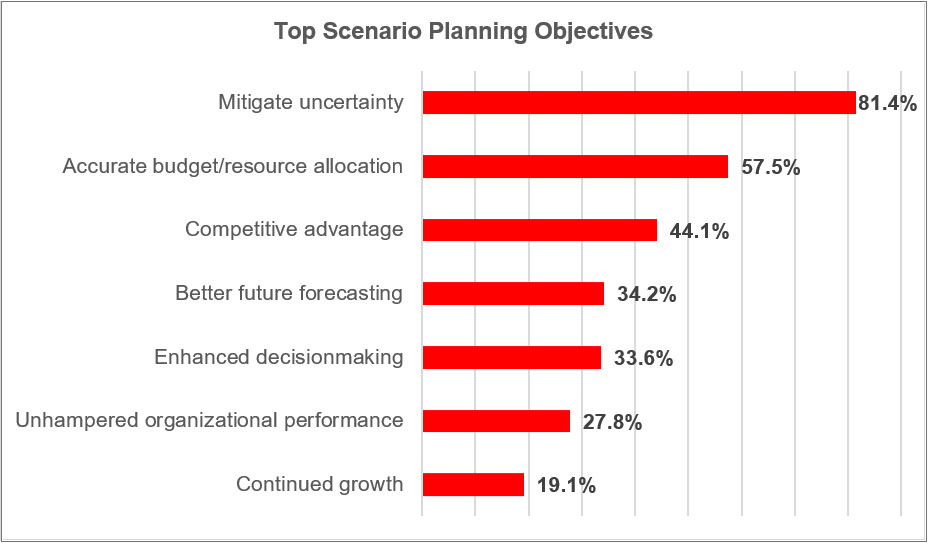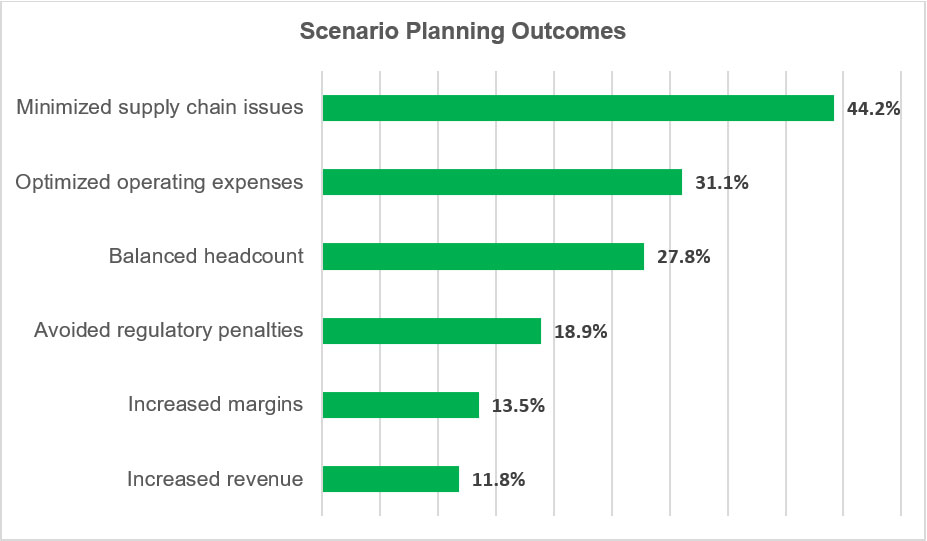Scenario Planning: Preparing for What’s Next

Does your business have a strategy to respond to uncertainty and potential disruptions? Business adaptation to unforeseen changes in the market is critical. Scenario planning helps organizations stay resilient, transforming challenges to growth opportunities.
Scenario planning is a tool for strategic thinking.
Scenario planning goes beyond traditional forecasting and planning, which rely on past data for prediction. Instead, it is a strategic thinking process that relies on data and risk analysis — using a variety of drivers, including external factors — to paint multiple pictures of what the future business environment might look like. In this way, organizations can become more agile when faced with rapid change.Such factors as cash and liquidity outlook, revenue estimates and risk mitigation can be tested to better position teams for positive business results. Participants in a recent survey cited specific goals for scenario planning.1

Fresh off the heels of a global pandemic, consumers and businesses are now worried about inflation, the trade battle between the U.S. and China, and the Ukrainian-Russian and Israel-Hamas wars. So, it’s no surprise that “mitigating uncertainty” is top of mind for most companies. Understanding how these global conflicts and the fluctuating economy will impact operations is key to mitigating associated risks.
What are the benefits of scenario planning?
Scenario planning helps businesses answer the “what ifs.” It is particularly helpful for business leaders who want to better prepare for potential variables that could negatively – or positively – impact company goals. With the right data, you can make informed projections that can be used to develop multiple, differentiated occurrences and possible outcomes. Some examples include:- Developing responses to micro- and macroeconomic trends.
- Estimating cash flow changes that occur as the result of external pressures, such as supply chain disruption.
- Responding to sudden market changes like a competitor going out of business or multiple competitors joining forces in a merger.
Identifying what you want to learn and setting clear goals is important. Business leaders who successfully implemented scenario planning achieved impressive results.

Supply chain issues improved in 2023 but are still fragile. In 2024, labor and wage disputes, as well as industrial and environmental policies will hamper the availability of goods needed for production.2
Fortunately, 44% of business leaders who participated in the GoodFirms’ study were able to analyze potential supply chain impacts and make necessary adjustments. Other accomplishments include optimizing expenses, balancing headcount, avoiding regulatory penalties, and increasing margins and revenue.
Which scenario planning model is best?
There are many types of scenario planning. Some models examine predetermined goals, while others evaluate possible unknown influences. The four most common models are:- Normative scenario planning
This model seeks to establish ideal operations that are based on a specific need or desired outcome. Since it examines variables specific to the targeted goal, the model is usually combined with other scenario planning methods. - Operational scenario planning
Perhaps the most popular method, operational scenario planning is directed to specific, often short-term events that could impact processes in which services and products are delivered. - Quantitative scenario planning
This method is most often used for financially based analysis with a limited number of key known variables. Changing the variables enables modeling for “worst” and “best” case scenarios. - Strategic management scenario planning
External factors, like the economy, geopolitical and relevant industries, are the basis for this model. Because it requires a very broad knowledge base, it is the most complex.
Determining which scenario plan is best depends on your company’s goals and objectives.
Create a strategic plan in five steps.
Of course, the overarching goal of businesses is sustainable, profitable operations. Creating a roadmap is even more important during uncertain economic times. A McKinsey & Company survey observed that 90% of CFOs used at least three scenarios in planning.3 Blending models to create a comprehensive strategic plan may be more complex, but basic steps should include:- List driving forces. What external and internal factors could impact your business goals? Use the PESTLE approach to identify the key political, economic, social, technological, legal, and environmental shifts that will affect your organization.
- Define the key indicators and trigger points. Which driving forces are you least familiar with? Which are most likely to impact or disrupt operations? Carefully examine these. These become the basis of the planning process. How will you know a potential uncertainty you've conceived is becoming a reality? Identify metrics to track to keep your organization informed and assign the actions you'll take and when.
- Develop a range of plausible scenarios. The objective is to identify and assess trends that are most likely to occur and have the greatest potential to affect your organization. Describe each possible event, who's involved, what strategies come into play and their associated outcomes. Consider good, better, and best responses, as well as what a bad response might be. Also ask what immediate, interim, and future responses could be. These become the basis of the planning process. Align your resources with scenario outcomes for more effective allocation that optimizes their use.
- Quantify the potential outcomes and impacts. A quantitative approach to possibilities and their effects will help better assess and prioritize unique risks. Consider a scenario planning template or software that offers quadrant analysis to simplify the exercise. Conduct stress tests to gauge effectiveness of strategies and refine responses.
Scenario planning enables businesses to identify early warning signs of varying circumstances and respond with a predetermined plan.
Uncertainty is a reality, but scenario planning helps better prepare for the unknown. To learn more about how to prepare for the unexpected, complete a short form and a Synovus Treasury & Payment Solutions Consultant will contact you with more details. You can also stop by one of our local branches.
Strategic Advice
Why is a Succession Plan Important?
Strategic Advice
Four Steps for Effective Market Planning
Strategic Advice
Five 2022 Business Planning Trends
-
Stay Liquid, Stay Flexible: Cash Flow and Investment Solutions for a Changing Interest Rate Environment
While inflation is inching towards normalcy, the Fed is considering just one interest rate cut this year. Three key elements will help develop an effective liquidity management plan.
-
In an Automated World, Check Fraud Still Thrives: Tips for Commercial Businesses
The Federal Reserve collected more than 3.1 million commercial checks last year. Yet, checks are most susceptible to fraud. Companies must take action to prevent fake check scams.
Important disclosure information
This content is general in nature and does not constitute legal, tax, accounting, financial or investment advice. You are encouraged to consult with competent legal, tax, accounting, financial or investment professionals based on your specific circumstances. We do not make any warranties as to accuracy or completeness of this information, do not endorse any third-party companies, products, or services described here, and take no liability for your use of this information.
- GoodFirms, “Scenario Planning - Objectives, Benefits, and Methods of Application,” accessed December 11, 2023 Back
- S&P Global Market Intelligence, “See the Big Picture, 2024 Supply Chain Outlook: Delivering Resilience in Adversity,” November 2023 Back
- McKinsey & Company, “Scenario-Based Cash Planning in a Crisis: Lessons for the Next Normal,” January 19, 2021 Back